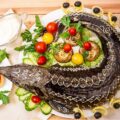- © shutterstock.com, Rashid Valitov
- © shutterstock.com, from my point of view
- © shutterstock.com, Chatham172
Saint Petersburg, member of the UNESCO Creative Cities Network in Gastronomy section, holds yearly Koryushka Festivals. Koryushka, or smelt, is a local fish that has become the regional brand. This is one of many examples of the special attitude towards fish that has played an important role in the Russian cuisine for centuries.
The Land of Water
The koryushka story dates back to the 18th century, when it provided sustenance to the growing population of the recently founded Saint Petersburg, the new Russian capital. It was such a crucial source of food that in 1705, Peter the Great issued a decree on the support of fishermen, and in the spring of 1708, a celebration dedicated to smelt was held in the city for the first time. This should not be a surprise: Russia has many bodies of water and people in various regions rely on them as a source of food, since harvests are hard to predict, but the lakes and rivers will never let you down!
Ivan the Terrible, who founded Arkhangelsk and annexed the Volga region, expanded Russia’s territory that now spread between the northern sea coasts to the southern Caspian, basically laying the groundwork for the nationwide fishing industry. During long and cold winters, fish could be transported by wagons from the places where it was caught to the central regions without salting, and during the warm season, sturgeons and sterlets from the Volga delta could be transported live using the extensive river network. Moreover, before the industrial era, rivers and lakes were a lot more abundant with fish. No wonder the envoy of the English king at the court of Tsar Alexei Mikhailovich in the 17th century wrote about Muscovites: “Despite the severity of the climate, they consume meat quite rarely… Meanwhile, this does not prevent them from being healthy and fat and having a good stature, which makes me believe the paradoxical thought that fish, which Muscovites eat most of the time, is as nutritious as meat.”
Indeed, due to its availability, fish served as an excellent alternative to meat and was used to prepare snacks, soups, main courses, and pies.
Proven by Centuries
There were numerous recipes for fish meals in Russia, and some of them have survived to the present day almost unchanged. Vasily Levshin (1746-1826), researcher of Old Russian cuisine and author of the book “Russian Cookery,” gave an exceptionally brief description of how to fry fish: “Taking any fish that is good for frying, whole if small or cut in pieces, upon gutting and scaling, if large, roll it in flour, fry in oil sprinkled with salt, serve on a platter.” A bit of flour, butter, salt — and that’s it! The main thing is to serve it while still hot. Fish could also be baked in the oven and fried in a large amount of fat or oil, sometimes wrapped in dough.
The recipe for boiled fish is also extremely simple — just boil it in salty water and then serve with a mixture of horseradish and vinegar. The only fancy twist that Vasily Levshin recommends is to “roll a large fish like a ring before serving, pinching its tail between its teeth.” Interestingly, in Russian cuisine fish was often served with sour sauces based on cucumber brine or vinegar to get rid of the specific fishy smell and provide the tender fish flesh with a pungent flavor. Sour cream is another proven way to accompany fish with sour notes. No wonder one character of a satirical fairy tale by Mikhail Saltykov-Shchedrin said: “I will say that again, crucian carps are such a delicious dish (especially fried in sour cream) that marshals of the nobility love to serve them to entertain even the governors.”
- © shutterstock.com, Fanfo
- © shutterstock.com, AS Foodstudio
- © shutterstock.com, teleginatania
Taste of the Past
Some recipes and ways of cooking fish have lost their popularity over time and are now forgotten. Take “telnoye” for example, an original Russian dish. Pavel Aleppsky, a 17th-century traveler and writer, left a description of this meal: “Muscovites take all the bones out of a fish, beat it up in mortars until it becomes soft like dough, then stuff it with a lot of onions and saffron, put it in molds in the form of sheep and geese and fry in vegetable oil on very deep baking trays so that it is fried all the way through. Then they cut it like pieces of fat tail before serving.” It is clear that such a time-consuming recipe could only be popular among the rich people. As life became simpler, cooking became simpler as well, and the modern descendants of this dish are zrazy, or fish cutlets.
Stuffed fish is another forgotten recipe. That dish used to be very nutritious and appetizing: hard-boiled buckwheat porridge was fried with finely chopped onions and caviar extracted from fish, and then this mixture was used to stuff the gutted bream, carp or any other fish suitable for such manipulations, that was then fried in a frying pan or baked in an oven. This method ensured that the cereal absorbs the fish juices, while the fish, in turn, acquires the flavor and juiciness thanks to the onions.
The list of liquid fish-based meals included not only the well-known ukha, or fish soup, but other soups as well, including jurma, a mixture of fish broth and game broth with pieces of meat, and tavranchuk. The author of “Domostroy” (the 16th-century set of household rules) ecstatically lists its varieties: sterlet tavranchuk, sturgeon tavranchuk, sevruga tavranchuk… Essentially, tavranchuk is liquid stew or thick soup in a pot: pieces of fish with half a glass of water or milk, onions and roots were put in the oven in a pot with a neck sealed with a layer of dough. Tavranchuk spent several hours in the stove sealed like that, to give enough time for the fragrant roots to saturate the flesh of the fish.
The Russian cuisine also actively used things that may seem strange to a modern foodie. These include jowl and viziga. Jowl is the head of a large sturgeon, boiled in broth until the cartilage becomes soft. Viziga is a sturgeon’s dried spinal cord, boiled and cut into small pieces beforehand. Both of these “semi-finished products” were very popular as a filling for pies. Interestingly, such pies were often served with fish soup, to round off the taste.
Made in USSR
Soviet period also made a significant contribution to the Russian tradition of fish meals. The 1930s mark the beginning of rapid development of the canning industry. Fish-canning plants were built near the capture sites to supply the whole country with tin cans of saury, salmon, sprat, and cod liver. These canned products were widely used in salads have become the classics of Soviet cuisine. For example, a salad with cod liver was very easy to make: all you needed to do was open a can, run off the oil, and then add finely chopped boiled eggs and green onions. By complementing it with canned peas, potatoes and pickles, you can easily transform it into a dish worthy of a festal meal.
Mimosa salad was designed specifically for special occasions: canned fish laid in layers and soaked in mayonnaise, boiled eggs, bulb onions, boiled carrots and grated cheese ensure that the dish has the most delicate mouthfeel and a very ornamental appearance. The final touch, top layer of grated yolk, provides resemblance to a blooming mimosa flower.
Royal Delicacy
When speaking of Russian fish cuisine, we simply cannot fail to mention caviar, this gastronomic symbol of Russia. When Ivan the Terrible conquered the Astrakhan region and annexed the mouth of the Volga river, black sturgeon caviar made its way to the tables of the entire population of the Russian state. Historian Nikolay Kostomarov noted that fresh grainy caviar from sturgeon and whitefish was delivered to rich houses, while ordinary people ate pressed caviar, richly salted and compressed in hessian sacks. Such caviar could be cut with a knife, like cheese, and it was even used to prepare special pancakes. Alexander Dumas, who visited Astrakhan in 1859, left a note about the scale of caviar production: “Caviar that was served to us was extracted from an enormous sturgeon that weighed three or perhaps even four hundred kilograms; it caviar filled eight ten-pound barrels.” Black caviar quickly gained popularity in the West and was exported in tons. Red caviar was also common in Russia, and it was conveniently near: in the 17-18th centuries, two types of salmonid fish, Caspian salmon and taimen, inhabited the Moscow River.
Of course, the volumes of red caviar consumption reached noticeable scale only with the reclamation of Siberia and the Far East and the establishment of transportation routes with this remote region.
In Soviet times, caviar turned into a national brand and a kind of PR tool. For example, one of the first scenes of the film “Moscow Does Not Believe in Tears” (1979) was shot against the showcase of a Moscow delicatessen store, and behind the characters we see a massive container with caviar that clearly shows the wealth of the Soviet people. In reality, caviar was of course a delicacy — for example, it was included in food gift baskets that enterprises presented to their employees on special occasions. In Russia, a jar of red or black caviar is still associated with holidays: on Maslenitsa, or Shrovetide, caviar is eaten with pancakes, and on New Year’s Eve people make sandwiches with it, spreading amber-colored pieces on butter. Because no matter how life goes, the holiday should be celebrated in a royal way!
Anadyr, Bugulma, Veliky Novgorod, Murmansk, Novy Oskol — these are only a few from a long list of Russian cities that have fish depicted on their coats of arms as a symbol of abundant seas and rivers. Even though the modern Russian fish cuisine is much simpler than in the days of tsars and princes, it is impossible to imagine a Russian festive table without fish baked until golden brown, fluffy fish cutlets and caviar sandwiches.
Tatiana Borisova






